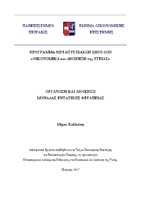Οργάνωση και διοίκηση Μονάδας Ενταντικής Θεραπείας
Organization and administration of Intensive Care Unit

Προβολή/
Λέξεις κλειδιά
Μονάδες Εντατικής Θεραπείας (ΜΕΘ) ; Υγεία ; Σύστημα υγείας ; Νοσοκομεία ; Ιδιωτική κλινική ; Αναπνευστήρας ; Οργάνωση ; Λειτουργία ; Σχεδιασμός ; Δείκτες ποιότητας ; Κόστος ; Intensive Care Unit ; Health ; Health system ; Hospitals ; Private clinic ; Ventilator ; Organization ; Operation ; Management ; Quality indicators ; CostΠερίληψη
Η υγεία είναι το πολυτιμότερο αγαθό του ανθρώπου και αποτελεί συνταγματικό δικαίωμα για τον κάθε πολίτη μιας αναπτυγμένης χώρας. Ο τομέας της υγείας με την έννοια της δυνατότητας προσφοράς κάποιων υπηρεσιών υγείας, είναι από τους πιο σύνθετους τομείς, σε κάθε οργανωμένη κοινωνία. Οι υπηρεσίες υγείας είναι μια δύσκολη έννοια που περιλαμβάνει τόσο την έννοια της φροντίδας όσο και της περίθαλψης. Η ανάπτυξη αυτού του τομέα έγινε βαθμιαία, χωρίς να υπάρχουν συγκεκριμένοι στόχοι, όμως στην πορεία επηρεάσθηκε από την εξέλιξη της επιστήμης, την οικονομία, τις ανθρώπινες αξίες και τις ανάγκες. Με την ανάπτυξη της Ιατρικής επιστήμης και την δημιουργία ιδρυμάτων υγειονομικής περίθαλψης όπως είναι τα νοσοκομεία, η ανάγκη της διαρκούς εξέλιξης στην οργάνωση, στη λειτουργία και στη διοίκηση είναι πολύ μεγάλη.
Κατά τη δεκαετία του 1950 ξεκινάει μια καινούρια περίοδος στο χώρο της Ιατρικής με την επιδημία της πολιομυελίτιδας καθώς ήταν η αφορμή για την ανάπτυξη της Εντατικής Θεραπείας. Την ίδια περίοδο χρησιμοποιήθηκε και ο αναπνευστήρας αρνητικής πίεσης («σιδηρούς πνεύμων»). Δεν γίνεται να υπάρχει νοσοκομείο χωρίς Μονάδα Εντατικής Θεραπείας. Η Εντατική Θεραπεία είναι μοναδική ανάμεσα στις υπόλοιπες ιατρικές ειδικότητες, αφού έχει ως στόχο την αντιμετώπιση του βαριά πάσχοντα και πολυσυστηματικού ασθενή, του οποίου η διαρκής παρακολούθηση και θεραπεία από εξειδικευμένο ιατρικό προσωπικό, έμπειρο νοσηλευτικό προσωπικό και με υψηλής τεχνολογίας εξοπλισμό παρέχει τη δυνατότητα έγκαιρης διάγνωσης και αποκατάστασης της υγείας του αρρώστου από σοβαρές και απειλητικές για τη ζωή του καταστάσεις.
Στην παρούσα διπλωματική εργασία, και πιο συγκεκριμένα στα 3 πρώτα κεφάλαια, γίνεται αναφορά στην έννοια της υγείας, στη δομή του συστήματος υγείας,
στην ιστορική εξέλιξη του Ελληνικού Συστήματος Υγείας και στην οργανωτική δομή της τριτοβάθμιας περίθαλψης.
Στο 4ο κεφάλαιο, μελετάμε την ειδικότητα της Ιατρικής που ασχολείται με τους βαριά πάσχοντες ασθενείς, την Επείγουσα και Εντατική Ιατρική. Στο 5ο και 6ο κεφάλαιο, αναφερόμαστε στο χώρο που αντιμετωπίζονται τέτοιου είδους κρίσιμα περιστατικά και αυτός ο χώρος είναι η Μονάδα Εντατικής Θεραπείας. Πιο συγκεκριμένα, μελετάμε τον ορισμό της, την ιστορική εξέλιξή της, το σκοπό της, τα είδη των ΜΕΘ, την οργάνωσή της, τι περιλαμβάνει η νομοθεσία για τη μονάδα και τέλος αναφερόμαστε στους αναπνευστήρες.
Στη συνέχεια, στο 7ο κεφάλαιο ασχολούμαστε με τη λειτουργία της ΜΕΘ και στο 8ο κεφάλαιο με τις κατασκευαστικές αρχές της. Στο 9ο κεφάλαιο με τα κριτήρια εισαγωγής των ασθενών στη ΜΕΘ και τα κριτήρια εξόδου από τη ΜΕΘ καθώς και στη γενικότερη διοίκησή της ενώ στο 10ο κεφάλαιο με τη στελέχωση του προσωπικού.
Τέλος, στο 11ο κεφάλαιο, γίνεται αναφορά στο σύστημα ποιότητας των Μονάδων Εντατικής Θεραπείας και στο τελευταίο κεφάλαιο στις διαφορές στις ΜΕΘ μεταξύ των χωρών και στο κόστος λειτουργίας τους.
Σκοπός της εργασίας αυτής είναι να μελετήσει την αναγκαιότητα ύπαρξης, τις υπηρεσίες που μπορεί να παρέχει μια Μονάδα Εντατικής Θεραπείας καθώς και τις απαραίτητες προϋποθέσεις που απαιτούνται για την κατασκευή και λειτουργία αυτών των μονάδων με στόχο την καλύτερη αντιμετώπιση και φροντίδα των βαριά πασχόντων ασθενών.


